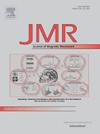使用酰胺15N CEST核磁共振实验研究“可见”蛋白质状态之间的缓慢交换
IF 1.9
3区 化学
Q3 BIOCHEMICAL RESEARCH METHODS
引用次数: 0
摘要
“可见”蛋白质状态之间的缓慢交换通常使用二维ZZ交换类磁化转移实验进行研究。然而,由于不同状态之间的磁化转移而产生的交叉峰可能导致二维ZZ交换NMR谱中的额外重叠。为了克服这种重叠问题,我们探索了15N CEST实验作为1HN-15N ZZ交换实验的替代方法,以研究“可见”蛋白质状态之间的交换。在双状态交换的情况下,1HN-15N相关图包含每个交换站点的两个相关性,每个状态产生一个相关性。因此,使用单个15N CEST实验,可以为每个站点记录两个15N CEST剖面。我们发现,通过同时分析在单个“高”B1场记录的这两个15N CEST剖面,并辅以实验得出的有关初始磁化的信息,或者像在ZZ交换实验的情况下,小态种群,可以获得特定位置的交换参数。通过研究T4溶菌酶的~ 18 kDa T34A突变体在其天然状态和填充到~ 21%(交换速率~ 5 s−1)的小状态之间的相互转换,证明了基于15N CEST的方法在可见蛋白状态之间交换的效用。本文章由计算机程序翻译,如有差异,请以英文原文为准。

Using the amide 15N CEST NMR experiment to study slow exchange between ‘visible’ protein states
Slow exchange between ‘visible’ protein states is often studied using the two-dimensional ZZ exchange class of magnetisation transfer experiments. However, the cross-peaks that arise due to magnetisation transfer between different states can lead to additional overlap in the two-dimensional ZZ exchange NMR spectrum. To overcome this overlap problem, here we have explored the utility of the 15N CEST experiment as an alternative to the 1HN–15N ZZ exchange experiment to study exchange between ‘visible’ protein states. In the case of two-state exchange, the 1HN–15N correlation map contains two correlations for each exchanging site, one arising from each state. Thus, two 15N CEST profiles can be recorded for each of these sites using a single 15N CEST experiment. We find that site-specific exchange parameters can then be obtained by simultaneously analysing both these 15N CEST profiles recorded at a single ‘high’ B1 field supplemented with experimentally derived information regarding the initial magnetisation or as in the case of the ZZ exchange experiment, the minor state population. The utility of the 15N CEST based approach to characterise exchange between visible protein states is demonstrated by studying the interconversion of the ∼18 kDa T34A mutant of T4 lysozyme between its native state and a minor state populated to ∼21 % (exchange rate ∼5 s−1) at 40 °C.
求助全文
通过发布文献求助,成功后即可免费获取论文全文。
去求助
来源期刊
CiteScore
3.80
自引率
13.60%
发文量
150
审稿时长
69 days
期刊介绍:
The Journal of Magnetic Resonance presents original technical and scientific papers in all aspects of magnetic resonance, including nuclear magnetic resonance spectroscopy (NMR) of solids and liquids, electron spin/paramagnetic resonance (EPR), in vivo magnetic resonance imaging (MRI) and spectroscopy (MRS), nuclear quadrupole resonance (NQR) and magnetic resonance phenomena at nearly zero fields or in combination with optics. The Journal''s main aims include deepening the physical principles underlying all these spectroscopies, publishing significant theoretical and experimental results leading to spectral and spatial progress in these areas, and opening new MR-based applications in chemistry, biology and medicine. The Journal also seeks descriptions of novel apparatuses, new experimental protocols, and new procedures of data analysis and interpretation - including computational and quantum-mechanical methods - capable of advancing MR spectroscopy and imaging.

 求助内容:
求助内容: 应助结果提醒方式:
应助结果提醒方式:


